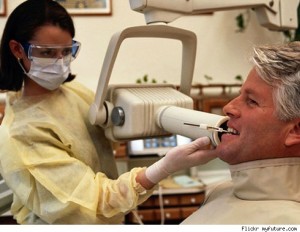Dental Career Field Structure
 Most dental care workers work in private dental offices. Other settings where dental care workers may be employed include hospitals, dental schools, research facilities, nursing homes, and the military.
Most dental care workers work in private dental offices. Other settings where dental care workers may be employed include hospitals, dental schools, research facilities, nursing homes, and the military.
The general dentist is the most familiar dental care worker. There are more than 150,000 dentists working in the United States today and approximately 85 percent of dentists work in a general dental practice. Much of a general dentist’s time is spent examining patients’ teeth and mouths, treating tooth decay with fillings, and providing crowns and bridges—in other words, restoring the teeth and mouth to function. Dentists also treat diseases affecting the soft tissue, such as gum disease and canker sores, and the jawbones, such as abscesses. General dentists also perform many of the treatments that are performed by specialists, but they may refer the most difficult cases to specialists. For example, general dentists perform routine root canals, treat mild gum disease, and extract teeth. General dentists may enter practice immediately after dental school, or they may pursue advanced education in general practice first.
Whereas a large portion of medical care is delivered by health maintenance organizations, most dental care is currently provided outside of managed-care programs, often with traditional fee-for-service insurance arrangements. However, managed care is making inroads into dental practice, and this trend is likely to continue.
Dentists who complete advanced training in a specialty may practice as dental specialists. There are nine officially recognized specialties in dentistry. Approximately 15 percent of all dentists are specialists.
Orthodontists correct problems in tooth and jaw alignment, usually through the use of orthodontic braces or removable appliances. While most orthodontic patients are children and teenagers, adults make up an increasing portion of the orthodontist’s caseload.
Oral and maxillofacial surgeons perform surgery on the mouth, jaws, and face. In addition to removing impacted wisdom teeth, they repair jaw fractures, remove cancerous tumors, and surgically correct poorly aligned jaws. Some oral surgeons perform plastic surgery procedures on the face.
Periodontists treat diseases of the gums and bones that support the teeth. They perform gum surgery, prescribe antibiotics, insert dental implants to replace missing teeth, and perform procedures to regenerate bone around the teeth.
There are five other dental specialties. Endodontists treat diseases and injuries that affect the tooth root. Root canal treatment involves drilling a hole in a tooth to gain access to the pulp within, removing the pulp tissue and nerves, and filling the root canal. In addition to providing root canal treatment, endodontists sometimes perform endodontic surgery. Pediatric dentists provide a broad range of dental care to children, from infancy through adolescence. Prosthodontists provide advanced treatment with dentures or bridges for people who have missing teeth. Many public health dentists work for the government to ensure that individual communities and the nation as a whole receive needed dental care. At the national level, public health dentists may work for the National Institutes of Health or the Centers for Disease Control and Prevention. States and cities may also employ them. Oral and maxillofacial pathologists often are responsible for diagnosing diseases that affect the bones and soft tissues of the mouth. They often examine specimens under a microscope. Oral and maxillofacial radiologists use radiant energy to diagnose and manage diseases, disorders, and conditions of the bones and soft tissues of the mouth.
Other groups of dentists seeking official specialty recognition are dental anesthesiologists and holistic dentists.
Most Americans are familiar with dental hygienists. The hygienist’s job usually includes cleaning the teeth above and below the gum line, taking X-rays, applying fluoride to teeth, and educating patients about dental hygiene practices, such as flossing. In some states, dental hygienists may practice independently, but in most states they may work only under a dentist’s supervision. Some dental hygienists teach courses at dental hygiene schools or work in research, administration, or insurance companies.
Dental assistants have less dental training than dentists and dental hygienists. They may be clinical or preventive dental assistants, working alongside the dentist while they are treating a patient. As infection control managers, dental assistants are responsible for disinfecting and sterilizing dental equipment. They often assemble instrument trays for the dentist’s use. Dental assistants also process X-rays, provide oral hygiene instruction to patients, schedule appointments, maintain supplies and records, and may process insurance claims and serve as dental practice managers.
The vast majority of dental laboratory technicians work in dental laboratories rather than dental offices. They make crowns, dentures, porcelain veneers, and other items needed to restore damaged teeth or replace missing teeth. They may also bend orthodontic wires into the proper shape.
Dental research offers scientific opportunities to dentists. Dental researchers may work for the National Institute of Dental and Craniofacial Research, a division of the National Institutes of Health. Many researchers work at universities and dental schools. The dental industry, which includes companies that make filling materials, dental instruments, medications, toothbrushes, and toothpaste, also employs and funds many researchers.
